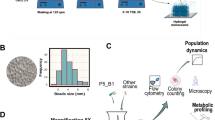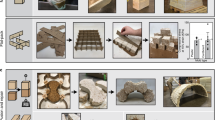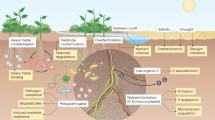Abstract
Interactions between the microbiota and their colonized environments mediate critical pathways from biogeochemical cycles to homeostasis in human health. Here we report a soil-inspired chemical system that consists of nanostructured minerals, starch granules and liquid metals. Fabricated via a bottom-up synthesis, the soil-inspired chemical system can enable chemical redistribution and modulation of microbial communities. We characterize the composite, confirming its structural similarity to the soil, with three-dimensional X-ray fluorescence and ptychographic tomography and electron microscopy imaging. We also demonstrate that post-synthetic modifications formed by laser irradiation led to chemical heterogeneities from the atomic to the macroscopic level. The soil-inspired material possesses chemical, optical and mechanical responsiveness to yield write–erase functions in electrical performance. The composite can also enhance microbial culture/biofilm growth and biofuel production in vitro. Finally, we show that the soil-inspired system enriches gut bacteria diversity, rectifies tetracycline-induced gut microbiome dysbiosis and ameliorates dextran sulfate sodium-induced rodent colitis symptoms within in vivo rodent models.

This is a preview of subscription content, access via your institution
Access options
Access Nature and 54 other Nature Portfolio journals
Get Nature+, our best-value online-access subscription
$29.99 / 30 days
cancel any time
Subscribe to this journal
Receive 12 print issues and online access
$259.00 per year
only $21.58 per issue
Buy this article
- Purchase on Springer Link
- Instant access to full article PDF
Prices may be subject to local taxes which are calculated during checkout





Similar content being viewed by others
Data availability
All data supporting the findings of this study are available within the Article, its Supplementary Information and Supplementary Files. Data are also available from the corresponding authors upon reasonable request. Source data are available at https://osf.io/muc9g/?view_only=971b8fde8562427ab619bc30c2624cb7. Source data are provided with this Paper.
Code availability
For PtychoShelves, code is available at https://www.psi.ch/en/sls/csaxs/software, and for PtychoLib, at https://github.com/kyuepublic/ptychopy.
References
Rodriguez-Caballero, E. et al. Dryland photoautotrophic soil surface communities endangered by global change. Nat. Geosci. 11, 185–189 (2018).
Zheng, D., Liwinski, T. & Elinav, E. Interaction between microbiota and immunity in health and disease. Cell Res. 30, 492–506 (2020).
Jimenez, M., Langer, R. & Traverso, G. Microbial therapeutics: new opportunities for drug delivery. J. Exp. Med. 216, 1005–1009 (2019).
Sakimoto, K. K., Wong, A. B. & Yang, P. Self-photosensitization of nonphotosynthetic bacteria for solar-to-chemical production. Science 351, 74–77 (2016).
Zhang, H. et al. Bacteria photosensitized by intracellular gold nanoclusters for solar fuel production. Nat. Nanotechnol. 13, 900–905 (2018).
Cestellos-Blanco, S., Zhang, H., Kim, J. M., Shen, Y. & Yang, P. Photosynthetic semiconductor biohybrids for solar-driven biocatalysis. Nat. Catal. 3, 245–255 (2020).
Liu, C., Colón, B. C., Ziesack, M., Silver, P. A. & Nocera, D. G. Water splitting-biosynthetic system with CO2 reduction efficiencies exceeding photosynthesis. Science 352, 1210–1213 (2016).
Guo, J. et al. Light-driven fine chemical production in yeast biohybrids. Science 362, 813–816 (2018).
Wang, T. et al. Bacteria-derived biological carbon building robust Li-S batteries. Nano Lett. 19, 4384–4390 (2019).
Ding, M. et al. Nanoelectronic investigation reveals the electrochemical basis of electrical conductivity in Shewanella and Geobacter. ACS Nano 10, 9919–9926 (2016).
Liu, C. et al. Nanowire–bacteria hybrids for unassisted solar carbon dioxide fixation to value-added chemicals. Nano Lett. 15, 3634–3639 (2015).
Su, Y. et al. Close-packed nanowire-bacteria hybrids for efficient solar-driven CO2 fixation. Joule 4, 800–811 (2020).
Cestellos-Blanco, S., Zhang, H. & Yang, P. Solar-driven carbon dioxide fixation using photosynthetic semiconductor bio-hybrids. Faraday Discuss. 215, 54–65 (2019).
Tang, T.-C. et al. Materials design by synthetic biology. Nat. Rev. Mater. 6, 332–350 (2021).
Huang, J. et al. Programmable and printable Bacillus subtilis biofilms as engineered living materials. Nat. Chem. Biol. 15, 34–41 (2019).
Liu, X. et al. Stretchable living materials and devices with hydrogel-elastomer hybrids hosting programmed cells. Proc. Natl Acad. Sci. USA 114, 2200–2205 (2017).
Wang, Y. et al. Living materials fabricated via gradient mineralization of light-inducible biofilms. Nat. Chem. Biol. 17, 351–359 (2021).
Gilbert, C. et al. Living materials with programmable functionalities grown from engineered microbial co-cultures. Nat. Mater. 20, 691–700 (2021).
O’Donnell, A. G., Young, I. M., Rushton, S. P., Shirley, M. D. & Crawford, J. W. Visualization, modelling and prediction in soil microbiology. Nat. Rev. Microbiol. 5, 689–699 (2007).
Young, I. M. & Crawford, J. W. Interactions and self-organization in the soil-microbe complex. Science 304, 1634–1637 (2004).
Chaparro, J. M., Sheflin, A. M., Manter, D. K. & Vivanco, J. M. Manipulating the soil microbiome to increase soil health and plant fertility. Biol. Fertil. Soils 48, 489–499 (2012).
Wargo, J. A. Modulating gut microbes. Science 369, 1302–1303 (2020).
Gupta, A., Osadchiy, V. & Mayer, E. A. Brain–gut–microbiome interactions in obesity and food addiction. Nat. Rev. Gastroenterol. Hepatol. 17, 655–672 (2020).
Peters, I. R., Majumdar, S. & Jaeger, H. M. Direct observation of dynamic shear jamming in dense suspensions. Nature 532, 214–217 (2016).
James, N. M., Han, E., de la Cruz, R. A. L., Jureller, J. & Jaeger, H. M. Interparticle hydrogen bonding can elicit shear jamming in dense suspensions. Nat. Mater. 17, 965–970 (2018).
Lelievre, J. Starch gelatinization. J. Appl. Polym. Sci. 18, 293–296 (1974).
Daeneke, T. et al. Liquid metals: fundamentals and applications in chemistry. Chem. Soc. Rev. 47, 4073–4111 (2018).
Zavabeti, A. et al. A liquid metal reaction environment for the room-temperature synthesis of atomically thin metal oxides. Science 358, 332–335 (2017).
Markvicka, E. J., Bartlett, M. D., Huang, X. & Majidi, C. An autonomously electrically self-healing liquid metal–elastomer composite for robust soft-matter robotics and electronics. Nat. Mater. 17, 618–624 (2018).
Dickey, M. D. Emerging applications of liquid metals featuring surface oxides. ACS Appl. Mater. Interfaces 6, 18369–18379 (2014).
Chen, S., Wang, H.-Z., Zhao, R.-Q., Rao, W. & Liu, J. Liquid metal composites. Matter 2, 1446–1480 (2020).
Hirsch, A., Dejace, L., Michaud, H. O. & Lacour, S. P. Harnessing the rheological properties of liquid metals to shape soft electronic conductors for wearable applications. Acc. Chem. Res. 52, 534–544 (2019).
Yan, J., Lu, Y., Chen, G., Yang, M. & Gu, Z. Advances in liquid metals for biomedical applications. Chem. Soc. Rev. 47, 2518–2533 (2018).
Goss, C. H. et al. Gallium disrupts bacterial iron metabolism and has therapeutic effects in mice and humans with lung infections. Sci. Transl. Med. 10, eaat7520 (2018).
Wegst, U. G. K., Bai, H., Saiz, E., Tomsia, A. P. & Ritchie, R. O. Bioinspired structural materials. Nat. Mater. 14, 23–36 (2015).
Munch, E. et al. Tough, bio-inspired hybrid materials. Science 322, 1516–1520 (2008).
Bai, H., Chen, Y., Delattre, B., Tomsia, A. P. & Ritchie, R. O. Bioinspired large-scale aligned porous materials assembled with dual temperature gradients. Sci. Adv. 1, e1500849 (2015).
Mao, L.-B. et al. Synthetic nacre by predesigned matrix-directed mineralization. Science 354, 107–110 (2016).
Deng, J. et al. Correlative 3D X-ray fluorescence and ptychographic tomography of frozen-hydrated green algae. Sci. Adv. 4, eaau4548 (2018).
van Soest, J. J. G., Tournois, H., de Wit, D. & Vliegenthart, J. F. G. Short-range structure in (partially) crystalline potato starch determined with attenuated total reflectance Fourier-transform IR spectroscopy. Carbohydr. Res. 279, 201–214 (1995).
Ramakers, L. A. I. et al. 2D-IR spectroscopy shows that optimized DNA minor groove binding of Hoechst 33258 follows an induced fit model. J. Phys. Chem. B 121, 1295–1303 (2017).
Wagner, S. & Bauer, S. Materials for stretchable electronics. MRS Bull. 37, 207–213 (2012).
Khan, M. R., Trlica, C., So, J.-H., Valeri, M. & Dickey, M. D. Influence of water on the interfacial behavior of gallium liquid metal alloys. ACS Appl. Mater. Interfaces 6, 22467–22473 (2014).
Humphries, J. et al. Species-independent attraction to biofilms through electrical signaling. Cell 168, 200–209 (2017).
Nimje, V. R. et al. Stable and high energy generation by a strain of Bacillus subtilis in a microbial fuel cell. J. Power Sources 190, 258–263 (2009).
Fan, Y. & Pedersen, O. Gut microbiota in human metabolic health and disease. Nat. Rev. Microbiol. 19, 55–71 (2021).
Wu, F. et al. Modulation of microbial community dynamics by spatial partitioning. Nat. Chem. Biol. 18, 394–402 (2022).
Zhou, H., Tai, J., Xu, H., Lu, X. & Meng, D. Xanthoceraside could ameliorate Alzheimer’s Disease symptoms of rats by affecting the gut microbiota composition and modulating the endogenous metabolite levels. Front. Pharmacol. 10, 1035 (2019).
Kong, C., Gao, R., Yan, X., Huang, L. & Qin, H. Probiotics improve gut microbiota dysbiosis in obese mice fed a high-fat or high-sucrose diet. Nutrition 60, 175–184 (2019).
Gerritsen, J. et al. Characterization of Romboutsia ilealis gen. nov., sp. nov., isolated from the gastro-intestinal tract of a rat, and proposal for the reclassification of five closely related members of the genus Clostridium into the genera Romboutsia gen. nov., Intestinibacter gen. nov., Terrisporobacter gen. nov. and Asaccharospora gen. nov. Int. J. System. Evol. Microbiol. 64, 1600–1616 (2014).
Zeng, Q. et al. Discrepant gut microbiota markers for the classification of obesity-related metabolic abnormalities. Sci. Rep. 9, 13424 (2019).
Xu, H.-M. et al. Selection strategy of dextran sulfate sodium-induced acute or chronic colitis mouse models based on gut microbial profile. BMC Microbiol. 21, 279 (2021).
Nadeau, P. et al. Prolonged energy harvesting for ingestible devices. Nat. Biomed. Eng. 1, 0022 (2017).
Steiger, C. et al. Ingestible electronics for diagnostics and therapy. Nat. Rev. Mater. 4, 83–98 (2019).
Mimee, M. et al. An ingestible bacterial-electronic system to monitor gastrointestinal health. Science 360, 915–918 (2018).
Zhang, S. et al. A pH-responsive supramolecular polymer gel as an enteric elastomer for use in gastric devices. Nat. Mater. 14, 1065–1071 (2015).
Lee, Y. et al. Therapeutic luminal coating of the intestine. Nat. Mater. 17, 834–842 (2018).
Singh, J. S., Pandey, V. C. & Singh, D. P. Efficient soil microorganisms: a new dimension for sustainable agriculture and environmental development. Agr. Ecosyst. Environ. 140, 339–353 (2011).
Chen, S. et al. The Bionanoprobe: hard X-ray fluorescence nanoprobe with cryogenic capabilities. J. Synchrotron Radiat. 21, 66–75 (2014).
Vogt, S. MAPS: a set of software tools for analysis and visualization of 3D X-ray fluorescence data sets. J. Phys. IV Proc. 104, 635–638 (2003).
Oliver, W. C. & Pharr, G. M. An improved technique for determining hardness and elastic modulus using load and displacement sensing indentation experiments. J. Mater. Res. 7, 1564–1583 (1992).
Oliver, W. C. & Pharr, G. M. Measurement of hardness and elastic modulus by instrumented indentation: advances in understanding and refinements to methodology. J. Mater. Res. 19, 3 (2004).
Callahan, B. J. et al. DADA2: high-resolution sample inference from Illumina amplicon data. Nat. Methods 13, 581–583 (2016).
Caporaso, J. G. et al. QIIME allows analysis of high-throughput community sequencing data. Nat. Methods 7, 335–336 (2010).
Segata, N. et al. Metagenomic biomarker discovery and explanation. Genome Biol. 12, R60 (2011).
Max, J.-J. & Chapados, C. Isotope effects in liquid water by infrared spectroscopy. III. H2O and D2O spectra from 6,000 to 0 cm−1. J. Chem. Phys. 131, 184505 (2009).
Bodis, P., Larsen, O. F. A. & Woutersen, S. Vibrational relaxation of the bending mode of HDO in liquid D2O. J. Phys. Chem. A 109, 5303–5306 (2005).
Sekkal, M., Dincq, V., Legrand, P. & Huvenne, J. P. Investigation of the glycosidic linkages in several oligosaccharides using FT-IR and FT Raman spectroscopies. J. Mol. Struct. 349, 349–352 (1995).
Cael, S. J., Koenig, J. L. & Blackwell, J. Infrared and Raman spectroscopy of carbohydrates: Part III: Raman spectra of the polymorphic forms of amylose. Carbohydr. Res. 29, 123–134 (1973).
Liu, Q., Charlet, G., Yelle, S. & Arul, J. Phase transition in potato starch-water system I. Starch gelatinization at high moisture level. Food Res. Int. 35, 397–407 (2002).
Cael, J. J., Koenig, J. L. & Blackwell, J. Infrared and Raman spectroscopy of carbohydrates. Part VI: normal coordinate analysis of V-amylose. Biopolymers 14, 1885–1903 (1975).
Acknowledgements
We thank Dr. K. Watters for the scientific editing of the manuscript. This work was supported by the US Office of Naval Research (N000141612958), the National Science Foundation (NSF CMMI-1848613) and a Zhong Ziyi Educational Foundation Award. This work was partially supported by the University of Chicago Materials Research Science and Engineering Center, which is funded by the National Science Foundation under award no. DMR-2011854. This work used instruments in the Electron Microscopy Service (Research Resources Center, UIC). This work made use of the BioCryo facility of Northwestern University’s NUANCE Center, which has received support from the SHyNE Resource (NSF ECCS-2025633), the IIN and Northwestern’s MRSEC programme (NSF DMR-1720139). Use of the Advanced Photon Source and the Center for Nanoscale Materials, both US Department of Energy Office of Science User Facilities, was supported by the US Department of Energy, Office of Science, under contract no. DE-AC02-06CH11357. The BNP was obtained through an NIH ARRA S10 grant no. SP0007167, and S.C. also acknowledges the support of DOE grant no. PRJ1009594. We also thank Dr. A. Tokmakoff and Dr. Z. Lu for their support and helpful discussions.
Author information
Authors and Affiliations
Contributions
B.T. supervised the research. Y.L. and B.T. conceived the idea. Y.L., X.G., J.Y. and B.T. developed the methods. Y.L., X.G., J.Y., Y.F., J.S., L.M., C.C., X.-X.Z., H.-M.T., F.S., J.H., Q.T., E.W.R., R.B., X.C., P.G., Z.C., J.D., S.C. and A.P. performed the experiments. Y.J., J.Y., H.-M.T. and F.M. analysed and processed the data. Y.L., X.G., J.Y. and B.T. wrote the paper, with comments from all authors.
Corresponding authors
Ethics declarations
Competing interests
The authors declare no competing interests.
Peer review
Peer review information
Nature Chemistry thanks the anonymous reviewer(s) for their contribution to the peer review of this work.
Additional information
Publisher’s note Springer Nature remains neutral with regard to jurisdictional claims in published maps and institutional affiliations.
Supplementary information
Supplementary Information
Supplementary Figs. 1–51 and Tables 1 and 2.
Supplementary Video 1
Focused ion beam tomography images of soil-inspired material showing the soil-inspired material is porous, which is consistent with X-ray ptychography and fluorescence imaging, and cross-sectional TEM images.
Source data
Source Data Fig. 2
FTIR spectra.
Source Data Fig. 3
Statistical source data.
Source Data Fig. 4
Statistical source data.
Source Data Fig. 5
Statistical source data.
Rights and permissions
Springer Nature or its licensor holds exclusive rights to this article under a publishing agreement with the author(s) or other rightsholder(s); author self-archiving of the accepted manuscript version of this article is solely governed by the terms of such publishing agreement and applicable law.
About this article
Cite this article
Lin, Y., Gao, X., Yue, J. et al. A soil-inspired dynamically responsive chemical system for microbial modulation. Nat. Chem. 15, 119–128 (2023). https://doi.org/10.1038/s41557-022-01064-2
Received:
Accepted:
Published:
Issue Date:
DOI: https://doi.org/10.1038/s41557-022-01064-2



